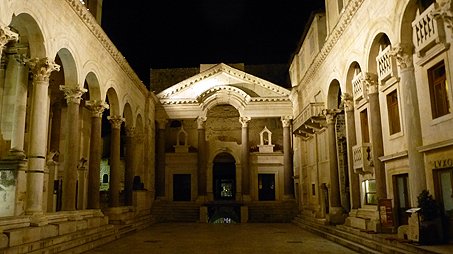Split geography
 Split is the largest city in Dalmatia and the second largest city in Croatia. According to the last census (2011), Split has almost 178,000 inhabitants. It’s the second largest Croatian cargo ports and one of the leading passenger ports in the Mediterranean.
Split is the largest city in Dalmatia and the second largest city in Croatia. According to the last census (2011), Split has almost 178,000 inhabitants. It’s the second largest Croatian cargo ports and one of the leading passenger ports in the Mediterranean.
Split is situated on the Split-Marjan peninsula, surrounded by the Adriatic Sea on three sides. The Marjan hill extends to the west of the peninsula. To the south of Split are the islands of Brac, Hvar, Solta and Ciovo.
Climate
Split has a Mediterranean climate, characterized by dry and hot summers and chilly, but mild and wet winters. The average temperature of the warmest month is above 22°C, while the coldest is above 4°C.
The city of Split
1700 years ago, on a peninsula near the large Roman town of Salona, the Roman emperor Diocletian decided to build a palace in which to spend the last years of his life in peace.This palace slowly grew to become a town known by the name of Split. Its rich tradition, glorious history, natural and cultural heritage last now 17 centuries to tell the story.

The Diocletian's Palace and the entire historical centre of Split are on the UNESCO world heritage list (since 1979). All layers of history are visible and alive - from ancient Rome, through the Middle Ages, until today. Walking through the ancient city you travel through time, discovering the superb examples of ancient architecture, medieval Romanesque churches, Gothic palaces, Renaissance portals, Baroque facades, all existing side by side in today’s modern city of Split.
All this is also reflected in the daily life of the city. Local residents sit in the same cafes, restaurants and shop in the same stores as the tourists do, creating the impression that they are an integral part of the city and its rhythm. The entire social life of the city is directed to its RIVA (waterfront promenade), where every visitor must enjoy a cup of coffee, sitting among noisy and temperamental local Split people.
Split is more than just a magnificent architectural scenery. When you get tired of the city noise, there is the Marjan hill, a symbol of the city, with its forests, trails for running, hiking, cycling and recreational grounds. Here you will also find old churches in which the people of Split sought spiritual calmness.
For a city, the size of Split, there are numerous beaches with unusually clear blue sea. From the famous sandy Bačvice beach to isolated rocky beaches around the entire Marjan hill.
A Brief history of Spalato (Split)
The history of Split is too rich to fit in just a few sentences but let’s try to make it as brief as possible. While it is known that Greek settlements previously existed in the area, it is widely accepted that the Emperor Diocletian was the founder and first resident of Split (Spalato). In 296 A.D., near the large city of Salona, the construction of a luxurious imperial palace begun. In just under 10 years, a 30 thousand square meters (180mx215m) big residence, was built. In 305 A.D., after he left the throne, the emperor Diocletian retreated to his new home.

The following turbulent centuries formed the city. Starting when the people of nearby Salona fled before the invading Avars and Slavs and found refuge in the palace. In succession, many powers extended its influence over the city, from the Croatian kings in the 10th century AD, the Hungarian and Venetian administration, to French rulers and the Austro-Hungarian monarchy. In the modern era and the 20th century Split "moves" from the Kingdom of Yugoslavia and the days of the Italian and German occupation, during World War II, to the socialist Yugoslavia and to the present day to a free and independent Croatia, a member of the European Union.





